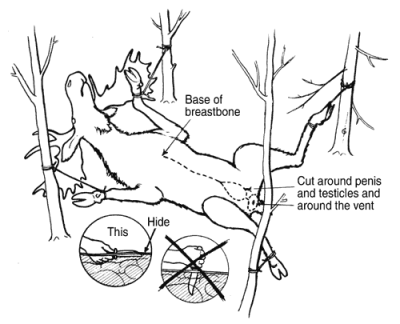Moose Game Care and Transport
Guide to field dressing, game care, and transporting of a harvested Moose
Moose Meat
Keep the meat cool, clean, and dry.
Moose spoil fast because they retain heat. The surest way to cool the me at is to field dress the moose and skin and quarter it immediately after the kill.
at is to field dress the moose and skin and quarter it immediately after the kill.
Field Dressing
Field Dressing Gear:
- 3.5-5 inch sharp knife (or two)
- Sharpening stone
- Wiping cloth
- Bone saw
- 100 ft of rope (tying open legs)
- Game bags or cheese cloth
- Tarp (keep meat dry & clean)
- Protective gloves and eyewear
- Pack frame and/or sled (transport)
- Blaze orange garments
Quartering- This is the fastest way to cool down the moose and ensure high quality meat. Avoid stacking the quarters on top of each other.
Hunters are required to bring the ovaries from cow moose to the registration station. Ovaries are easiest to find prior to removing the internal organs. See the video below by the Maine Department of Inland Fisheries and Wildlife have instructions. Ovaries provide important data for determining the productivity of the population.
Meat lockers that will take moose can be found in the updated Game Meat Butchers list on the main NH Fish and Game moose hunting page. Most meat cutters require notice months in advance.
Pure blood collected while field dressing the moose is used to monitor for disease. This sample is optional, but greatly appreciated. See document for instructions.
Moose Meat Warnings
Cadmium in Organ Meats:
The results of a study indicate that consumption of moose liver or kidney may lead to a daily intake of cadmium exceeding recommended levels. Because particularly high cadmium levels have been seen in some moose liver and kidney, the NH Department of Public Health recommends not consuming these organ meats.
Echinococcus granulosus
Ingestion of canid feces that fed on infected moose can result in humans developing cysts in their lungs. For more information see Human Health Risk: Echinococcus granulosus.



